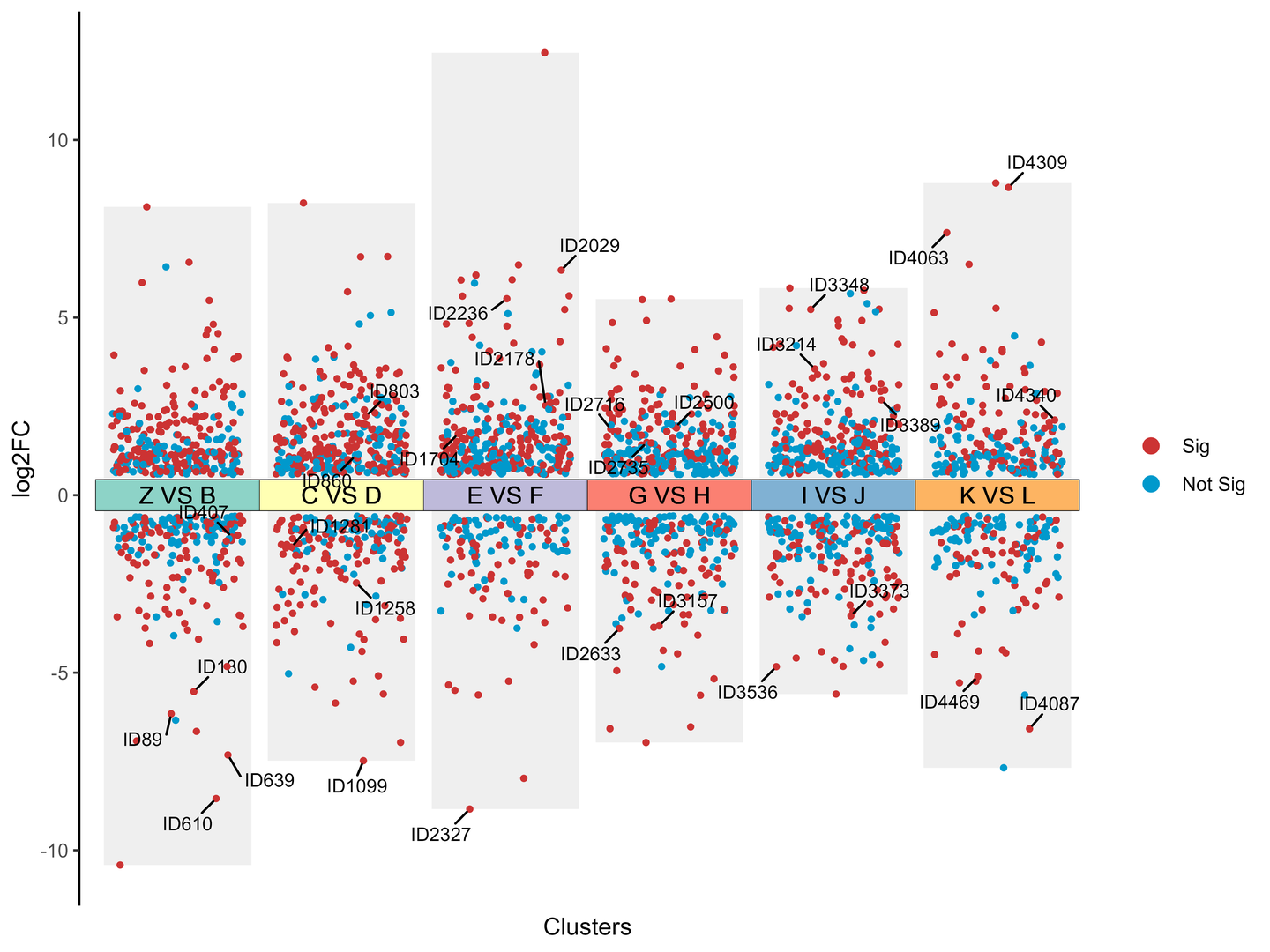# A tibble: 4,586 x 4
Name FC PValue Cluster
<chr> <dbl> <dbl> <chr>
1 ID1 0.139 0.00749 Z VS B
2 ID2 1.19 0.801 Z VS B
3 ID3 0.777 0.00172 Z VS B
4 ID4 2.42 0.0391 Z VS B
5 ID5 0.840 0.747 Z VS B
6 ID6 1.80 0.00173 Z VS B
7 ID7 2.47 0.0164 Z VS B
8 ID8 1.76 0.00967 Z VS B
9 ID9 0.964 0.923 Z VS B
10 ID10 0.746 0.510 Z VS B
# i 4,576 more rowsR语言如何绘制多组差异火山图
前言
本篇是R语言如何绘制多组差异火山图的教程,普通的火山图内容介绍可以看这里:https://www.r2omics.cn/docs/gallery/omicsChart/volcano/volcano.html
什么是多组差异火山图?
多组差异火山图是火山图的变种,与传统的火山图相比,可以在一张图上展现多个比较对的差异情况。
纵坐标表示基因或蛋白质的表达水平变化倍数log2FC,横坐标每簇代表一个比较对。在一张图上可以同时展示多个比较对,通过颜色的使用,将差异与非差异区分出来,帮助研究人员更清晰地了解不同样本间的差异情况。

绘图前的数据准备
demo数据可以在https://www.r2omics.cn/res/demodata/mutiVolcano.txt下载。
必须包含4列数据。4列分别是名称列,FC列,PValue列,Cluster列(比较对列)
R语言怎么画多组差异火山图
先自定义一个函数,之后我们直接调用它
# 代码来源:https://www.r2omics.cn/
#加载包
library(tidyverse)
library(ggrepel) # 用于标记
# 自定义一个函数,之后我们直接调用它
mutiVolcano = function(df, # 绘图数据
P = 0.05, # P值卡值
FC = 1.5, # FC卡值
GroupName = c("Sig","Not Sig"), # 分组标签
pointColor = c("#CC3333","#0099CC"), # 分组散点的颜色
barFill = "#efefef", # 柱子的颜色
pointSize = 0.9, # 散点的大小
labeltype = "1", # 标记差异基因的选项,标记类型有"1"和"2"两种选项
labelNum = 5, # 当标记类型为1时,待标记的散点个数
labelName =NULL, # 当标记类型为2时,待标记的散点名称
tileLabel = "Label", # 标记比较对的选项,选项有“Label”和“Num”,Label时显示分组名称,Num时显示数字,防止因为标签太长导致的不美观
tileColor = NULL # 比较对的颜色
){
# 数据分组 根据p的卡值分组
dfSig = df %>%
mutate(log2FC = log2(FC)) %>%
filter(FC>{{FC}} | FC <(1/{{FC}})) %>%
mutate(Group = ifelse(PValue<0.05,GroupName[[1]],GroupName[[2]])) %>%
mutate(Group = factor(Group,levels=GroupName)) %>%
mutate(Cluster = factor(Cluster,levels=unique(Cluster))) # Cluster的顺序是文件中出现的顺序
# 柱形图数据整理
dfBar = dfSig %>%
group_by(Cluster) %>%
summarise(min = min(log2FC,na.rm = T),
max = max(log2FC,na.rm = T)
)
# 散点图数据整理
dfJitter = dfSig %>%
mutate(jitter = jitter(as.numeric(Cluster),factor = 2))
dfJitter
# 整理标记差异基因的数据
if(labeltype == "1"){
# 标记一
# 每组P值最小的几个
dfLabel = dfJitter %>%
group_by(Cluster) %>%
slice_min(PValue,n=labelNum,with_ties = F) %>%
ungroup()
}else if(labeltype == "2"){
# 标记二
# 指定标记
dfLabel = dfJitter %>%
filter(Name %in% labelName)
}else{
dfLabel = dfJitter %>% slice()
}
# 绘图
p = ggplot()+
# 绘制柱形图
geom_col(data = dfBar,aes(x=Cluster,y=max),fill = barFill)+
geom_col(data = dfBar,aes(x=Cluster,y=min),fill = barFill)+
# 绘制散点图
geom_point(data = dfJitter,
aes(x = jitter, y = log2FC, color = Group),
size = pointSize,
show.legend = NA
)+
# 绘制中间的标签方块
ggplot2::geom_tile(data = dfSig,
ggplot2::aes(x = Cluster, y = 0, fill = Cluster),
color = "black",
height = log2(FC) * 1.5,
# alpha = 0.3,
show.legend = NA
) +
# 标记差异基因
ggrepel::geom_text_repel(
data = dfLabel,
aes(x = jitter, # geom_text_repel 标记函数
y = log2FC,
label=Name),
min.segment.length = 0.1,
max.overlaps = 10000, # 最大覆盖率,当点很多时,有些标记会被覆盖,调大该值则不被覆盖,反之。
size=3, # 字体大小
box.padding=unit(0.5,'lines'), # 标记的边距
point.padding=unit(0.1, 'lines'),
segment.color='black', # 标记线条的颜色
show.legend=F)#+
if(tileLabel=="Label"){
p =
p +
geom_text(data = dfSig,aes(x = Cluster,y = 0,label = Cluster))+
ggplot2::scale_fill_manual(values = tileColor,
guide = NULL # 不显示该图例
)
}else if(tileLabel=="Num"){
# 如果比较对的名字太长,可以改成数字标签
p =
p +
geom_text(data = dfSig,aes(x = Cluster,y = 0,label = as.numeric(Cluster)),show.legend = NA)+
ggplot2::scale_fill_manual(values = tileColor,
labels = c(paste0(1:length(unique(dfSig$Cluster)),": ",unique(dfSig$Cluster))))
}
# 修改主题
p = p+ggplot2::scale_color_manual(values = pointColor)+
theme_classic()+
ggplot2::scale_y_continuous(n.breaks = 5) +
ggplot2::theme(
legend.position = "right",
legend.title = ggplot2::element_blank(),
legend.background = ggplot2::element_blank(),
axis.text.x = element_blank(),
axis.ticks.x = element_blank(),
# axis.title.x = element_blank(),
axis.line.x = element_blank()
) +
ggplot2::xlab("Clusters") + ggplot2::ylab("log2FC") +
# ggplot2::guides(fill = ggplot2::guide_legend())
guides(color = guide_legend(override.aes = list(size = 3)))
return(p)
}调用刚才的自定义函数
# 代码来源:https://www.r2omics.cn/
# 读数据
df = read.delim("https://www.r2omics.cn/res/demodata/mutiVolcano.txt") %>% # 这里直接读取网络上的数据
as_tibble() %>%
set_names(c("Name","FC","PValue","Cluster"))
# 调用函数画图
mutiVolcano(
df = df, # 绘图数据
P = 0.05, # P值卡值
FC = 1.5, # FC卡值
GroupName = c("Sig","Not Sig"), # 分组标签
pointColor = c("#CC3333","#0099CC"), # 分组散点的颜色
barFill = "#efefef", # 柱子的颜色
pointSize = 0.9, # 散点的大小
labeltype = "1", # 标记差异基因的选项,标记类型有"1"和"2"两种选项
labelNum = 5, # 当标记类型为1时,待标记的散点个数
labelName =c("ID1","ID2029"), # 当标记类型为2时,待标记的散点名称
tileLabel = "Label", # 标记比较对的选项,选项有“Label”和“Num”,Label时显示分组名称,Num时显示数字,防止因为标签太长导致的不美观
tileColor = RColorBrewer::brewer.pal(length(unique(df$Cluster)),"Set3") # 比较对的颜色
)